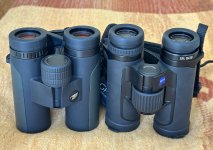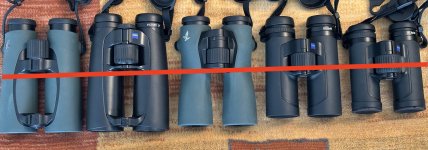Canip, (a) I’m interested in how binocular users’ preferences change with their age and vision, and (b) I much value your assessments of binoculars (as Canip or Pinac). Could you please give a list like the above for the time when your vision was at its best? Thank you!
Tks Andy. I am not sure I can answer this to your satisfaction.
Caveat: if you read the entire post # 147, the list you are quoting was the result not only of changes in vision acuity, but also some binos or even brands may have lost their preferrred spot because of mechanical or similar "incompatibilities". Could still be a question of age, though.
I once had a list of prefererred binos from earlier times, but it is long gone.
Generally, over time I have been valuing
ergonomics more than in the beginning. This and narrow FOVs are reasons why I am not very fond of current IS binos, which I enjoyed more back in time (I value the optics and IS on the 10x42 Canon, which I consider the best current IS bino, but hate its shape, eyecups etc.). Using an IS bino has now been almost fully replaced by handheld low mag observation or 8x / 10x / 12x observation from a tripod.
I used to go out years ago with a 8x or even 10x bino ffor dog walks, but am now usually equipped with a 6x, 6.5x or 7x and think they are more helpful on the run - smaller details, but less shaking, overall more satisfaction.
Then, the "acute"
brilliance and sharpness of, say, an EL SV which once took top priority in my preferences has since made space for the somehow (as percieved by me) color richer image of a Leica UV, which I perceive as less sharp (still sharp enough

) , but pleasantly high in contrast and in a way more "natural". In this sense, if I once thought in general terms about the premium manufacturers, just considering their product portfolio, I would rate them Swaro - Zeiss - Leica - Nikon (top to bottom); nowadays, it is Leica - Zeiss - Swaro - Nikon.
Also, smoooth and precise
focusers with no play are more important to me now than 30 years ago. Not once in my life did I have to send in a Leica for repairs on a focuser (for other things, yes.) Both Swaros and Zeisses had to be sent in because of issues with the focuser, and my recent experience (reported in another post) leads me to believe that Zeiss has gotten focuser design under control, but Swarovski seems not to have, (just my own experience; even if many focusers on my Swaro binos do their job, I rarely get the smoothness that an SFL provides; YMMV).
FOV: I once was obsessed with
widefield design. More recently, I have come back a bit on this; I enjoy the FOV in the NL or SF very much, but now don't mind if it's a bit less, say, 8 degrees or so in an 8x bino or (the SFL just fits the bill) if image characteristics are otherwise pleasant. How much my satisfaction with narrower fields has to do with the aging of my eyes, I can't say, but there may be a connection.
I never had much issue with globe effect or
distortion phenomena, and this has not changed with time.
Unsatisfactory
CA correction was no big deal for me in earlier times, but with modern bino design and glasses, this is now no major issue anyway (many CA issues debated here and in other forums have a lot to do with eye placement etc.).
Canip










